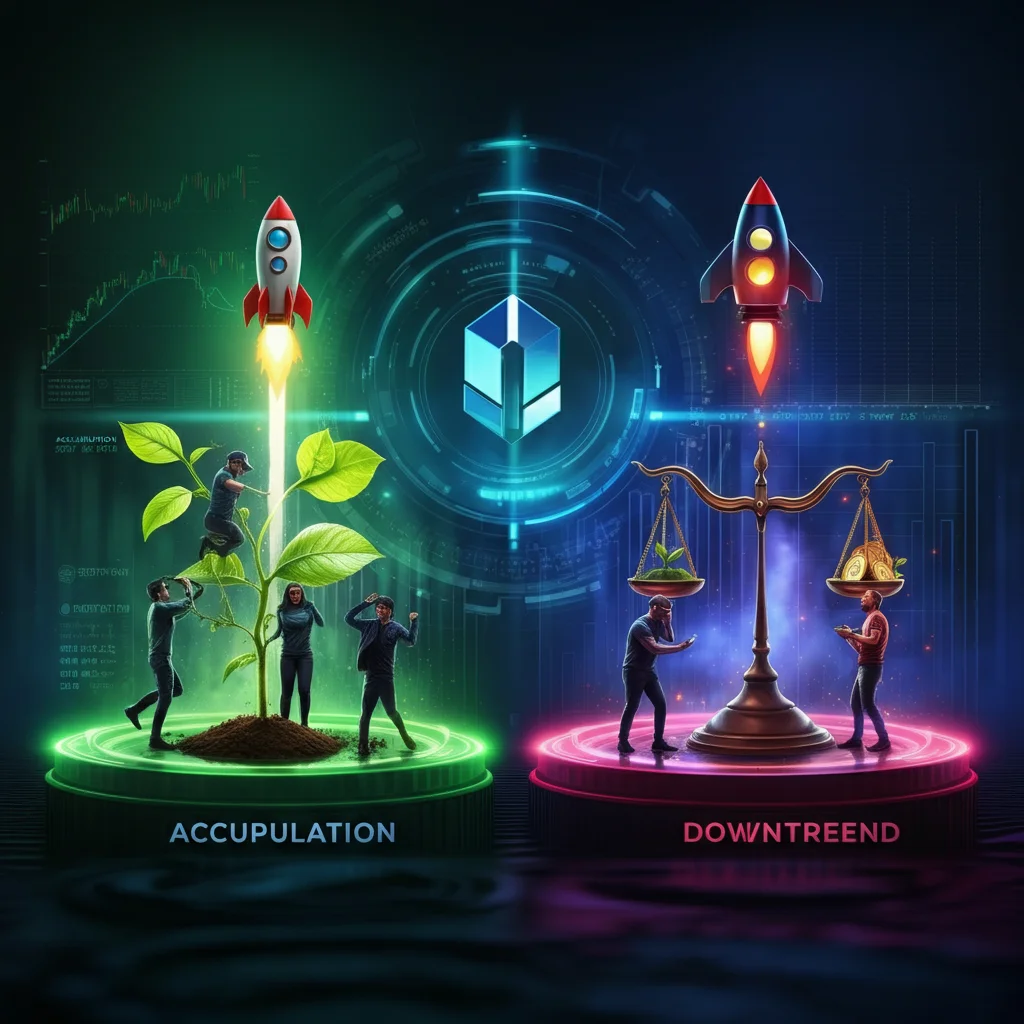If you're navigating the cryptocurrency space, you've probably heard phrases like "bull market," "bear market," or "market cycles." But what exactly do these terms mean, and how do they shape your investment strategy? Understanding crypto market cycles is essential for making informed decisions and mitigating risk in the volatile world of cryptocurrencies.
This blog will break down the concept of market cycles in crypto, explore their stages, highlight the role of investor psychology, look at historical examples, and provide actionable insights for using cycles to make smarter investment decisions.
What Are Market Cycles in Crypto?
A market cycle refers to the natural oscillation between bullish (rising) and bearish (falling) trends in the cryptocurrency market. These cycles are driven by market sentiment, external events, and investor behavior and often play out over months or years.
Unlike traditional assets, cryptocurrencies operate in a relatively young and speculative market. This means crypto market cycles tend to be sharper and shorter, characterized by meteoric rises and steep corrections. To succeed as an investor, understanding and recognizing the phases of these cycles is crucial.
Why Do Market Cycles Matter?
Market cycles are not just abstract concepts; they determine how investors approach their strategies. Whether you're a long-term holder or an active day trader, recognizing what stage of the cycle you're in can help you decide when to buy, sell, or hold your assets.
Cryptos like Bitcoin and Ethereum tend to follow these cycles closely. Smaller altcoins, while more volatile, often mirror the broader sentiment established by leading coins.
The Stages of Crypto Market Cycles
Market cycles consist of four distinct phases. Understanding these will help you better predict market movements and adjust your strategies accordingly.
1. Accumulation
This phase occurs after a prolonged downtrend or bear market. Prices stabilize at relatively low levels, and trading volume tends to decrease. During this stage:
Sentiment is generally pessimistic or apathetic as public interest in crypto wanes.
Institutional investors and savvy market participants begin accumulating crypto assets at undervalued prices.
News cycles around crypto remain quiet, with few "hype stories" capturing public attention.
What Should You Do in the Accumulation Phase?
This is the ideal time to research projects and build positions gradually. Dollar-cost averaging (DCA) is highly effective during this phase, allowing you to invest consistently without trying to time the market.
2. Uptrend (Bull Market)
The uptrend phase is when the market begins its ascent. Prices start to climb, often fueled by an influx of new investors, positive news, and increasing demand. This stage is marked by:
Rising trading volumes and bullish sentiment.
Breakout events like Bitcoin halving cycles or major institutional adoption.
Media coverage returning, spurring FOMO (fear of missing out) among latecomers.
What Should You Do in the Uptrend Phase?
Evaluate your portfolio and consider taking profits on the way up. Resist emotional buying during periods of extreme euphoria, as this often leads to entry points near market peaks.
3. Distribution
The distribution phase signals a potential market top. While prices may continue to spike, they typically become volatile, fluctuating within a range. Here, smart money (experienced investors) starts liquidating positions to less experienced participants.
This stage is often characterized by:
Greedy sentiment and unrealistic price predictions ("Bitcoin to $500,000!").
Increasing speculative investments in newer, riskier altcoins.
Over-leveraging among traders, fueled by excessive confidence.
What Should You Do in the Distribution Phase?
Stay disciplined. If you've hit your investment goals, take profits and avoid risky trades. Watch for signs that sentiment is becoming driven more by hype than fundamentals.
4. Downtrend (Bear Market)
The downtrend marks the final stage of the cycle, with prices declining significantly. Panic selling, negative news, and disillusionment dominate this phase. Common characteristics include:
Sharp corrections or crashes in valuations.
Fear and uncertainty among investors, leading to capitulation.
Projects with weak fundamentals collapsing under market pressure.
What Should You Do in the Downtrend Phase?
Preserve capital. Avoid panic selling unless you've determined the fundamentals have changed for the worse. Use the downtrend as an opportunity to reassess your portfolio and identify strong assets for the next accumulation phase.
The Role of Investor Psychology
Market cycles are influenced as much by human emotion as by macroeconomic factors. Investor psychology plays a pivotal role in shaping each stage of the cycle:
Greed drives buying behavior in the uptrend and distribution phases.
Fear leads to massive sell-offs during the downtrend.
Apathy characterizes the accumulation phase when investors are disinterested.
Understanding these emotional triggers can help you make rational decisions, even when the market is anything but rational.
Common Pitfalls Tied to Psychology
FOMO (Fear of Missing Out) often leads investors to buy near the top.
Panic Selling causes investors to lock in losses unnecessarily during corrections.
Overconfidence in Bull Markets can push investors to take excessive risks.
Learning to identify and counter these psychological tendencies is a key to long-term success as a crypto investor.
Historical Examples of Crypto Market Cycles
The crypto market's history is ripe with examples of dramatic cycles. Here are two notable cases:
1. The 2017 Bull Run
Bitcoin rose from under $1,000 in January to nearly $20,000 by December. The euphoria extended to altcoins like Ethereum and Ripple. However, this was followed by a sharp correction in 2018, which erased nearly 80% of the market's value.
2. The 2021 Bull Run and Correction
Fueled by institutional interest and increased adoption, Bitcoin hit an all-time high above $64,000 in April 2021. The market corrected significantly after regulatory concerns in China and environmental criticism of crypto mining, creating a new downtrend.
These examples underline the importance of understanding market cycles and having a strategy in place for every stage.
Indicators to Track Market Sentiment
Recognizing where you are in the market cycle often comes down to identifying key signals. Here are useful indicators to monitor:
Fear & Greed Index: A visual representation of current market sentiment.
Trading Volume: High volumes often signify major shifts in sentiment.
Relative Strength Index (RSI): Determines whether an asset is overbought or oversold.
Google Trends: Analyzes search interest in crypto-related terms. Spikes often indicate FOMO is kicking in.
News & Social Media Sentiment: Assess how crypto is being discussed on major platforms like Twitter and Reddit.
By combining these tools, you can make more informed decisions about market positioning.
Using Market Cycles to Inform Investment Decisions
Understanding crypto cycles can help you:
Time Your Entries and Exits:
Buy during accumulation phases when prices are low.
Consider taking profits during the uptrend and distribution stages.
Diversify and Reallocate:
Hold a mix of assets to hedge against wide valuation swings.
Reallocate funds from overvalued assets into undervalued ones.
Stay Long-Term Focused:
For long-term investors, cycles are less about quick trades and more about building wealth by navigating highs and lows with discipline.
Combine Fundamentals with Cycles:
Always evaluate the underlying value and utility of cryptocurrencies in addition to assessing market cycles.
The Takeaway on Crypto Cycles
Navigating crypto market cycles requires a blend of strategy, discipline, and emotional resilience. While crypto's volatility may seem overwhelming at first, learning to identify and leverage market cycles equips you to make smarter, more confident investment decisions.
If you're ready to improve your understanding of the crypto market, start following sentiment indicators and study past cycles to recognize patterns. While no one can predict the future, understanding market cycles gives you a powerful advantage in the complex world of cryptocurrency investments.



